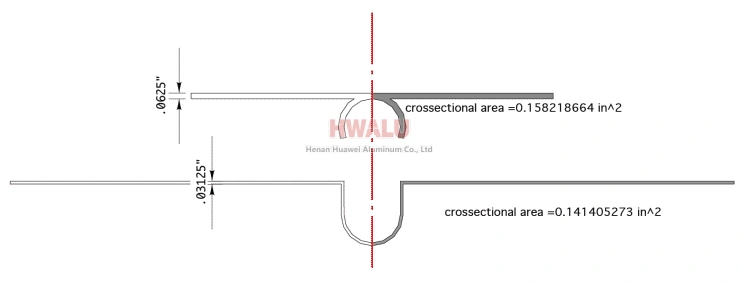La seguente analisi agli elementi finiti (BRUTTA) i risultati dello studio confrontano l'efficienza delle alette utilizzando fogli di alluminio spessi estrusi e sottili stampati. I parametri di questo studio sono:
120°F temperatura dell'acqua nei tubi, 70°F temperatura dell'aria sopra e sotto il gruppo del pavimento, 8″ spaziatura dei tubi, 1/2″ PEX, 2.0 Btu/ora/ft2/F, 8″ coefficiente di scambio termico x 1/32″ targa stampata e 4″ x1/16″ piastra estrusa con contatto non distruttivo tra alette e sottopavimento.
Una nota sullo studio FEA: I risultati riflettono solo una combinazione dei parametri di cui sopra e si consiglia al lettore di non trarre conclusioni basate su parametri che non sono stati studiati. Questi risultati non dovrebbero inoltre essere indicativi di condizioni transitorie come l'avvio, né dovrebbero tenere conto del contatto distruttivo (cioè. spazi d'aria dovuti alla torsione e alla flessione delle alette, una proprietà intrinseca dei sistemi a piastre sottili). Inoltre, il modello non tiene conto del trasporto 3D lungo la tubazione, cioè. quanta energia viene estratta dal tubo lungo la sua lunghezza.
INFORMAZIONI: Qualsiasi combinazione di parametri non studiati produrrà risultati diversi rispetto al grafico sottostante. Inoltre, data la scelta tra lastra e nessuna lastra, ai lettori viene detto che i sistemi senza lastre, in particolare i sistemi in cui i tubi sono installati lateralmente ai travetti o sospesi in aria tra i travetti, sono i meno efficienti per il riscaldamento del pavimento. metodo. Nel secondo caso, è come togliere una pentola d’acqua dal fornello e scaldarla. In tutto tranne che nei climi più caldi e/o nelle case più efficienti come R2000 o PassiveHaus, i sistemi montati lateralmente, sospesi o senza pannelli possono distruggere l'efficienza della caldaia poiché metodi di installazione inefficaci richiedono temperature più elevate.
Oltre a valutare l'utilizzo delle piastre di trasferimento termico, gli utilizzatori dovranno inoltre valutare il potenziale di amplificazione sonora delle piastre dovuto alla dilatazione e contrazione del tubo. Per garantire un pavimento climatizzato silenzioso ed efficace, è necessario seguire i metodi di installazione specifici dei produttori di tubi in alluminio.

Figura 1. Profilo dell'estruso (superiore) e timbrato (metter il fondo a) piastre di trasferimento del calore in alluminio utilizzate per sistemi di raffreddamento e riscaldamento radianti a pavimento.

Figura II. Risultati grafici dello studio. A causa della maggiore area di contatto e conduttività, le piastre estruse forniscono temperature superficiali più elevate dal punto b al punto b’ rispetto alle pinne sottili. Ciò rappresenta una larghezza di circa 2.5 pollici. Vicino al bordo della piastra estrusa in c e c’, notare il degrado termico dal punto b al punto c, dal punto c al punto d, punto b’ a c’ e il punto c’ a d'. Questo perché il profilo 4″ (c a c') è più stretto del profilo stampato 8″ (e a e'), dove da c a d e c’ a d’ rappresentano la temperatura superficiale del sottopavimento non placcato.
Notare che, a parità di tutti gli altri fattori, la maggiore temperatura di picco fornita dalla piastra estrusa comporta anche una minore temperatura del fluido di ritorno, che migliora l'efficienza della caldaia. Basato su studi che utilizzano i parametri descritti, il polistirene estruso è una buona scelta per campate di travetti più strette con pavimenti ad alta resistenza e dove i valori della temperatura del flusso di ritorno sono bassi. Uno studio più dettagliato delle diverse combinazioni fornirà ulteriori risultati comparativi.

Figura 3. Dettagli di montaggio per estruso 1/16″ x4″ piastra in alluminio. Prendere nota della linea centrale della catena di conduttanza del tubo, piatto e legno. Con questo profilo la piastra facilita la conduttanza dal tubo nel legno in modo più efficace rispetto alla piastra stampata mostrata in Figura 5 e figura 6.

Figura 4. Isoterme dipinte a colori dall'analisi degli elementi finiti (BRUTTA) per l'estruso 1/16″ x4″ piastra in alluminio. Notare l'intensità termica attorno alla piastra estrusa rispetto alla piastra stampata mostrata di seguito in Figura 6. Questo tipo di piastra è più efficace nell'estrarre il calore dal tubo con conseguente temperatura di ritorno più bassa che migliora l'efficienza della caldaia.

Figura 5. Dettagli di montaggio per estruso 1/32″ x8″ piastra in alluminio. Notare l'area ridotta e la conduttività sulla linea centrale per questa specifica piastra stampata, ciò si traduce in una temperatura superficiale inferiore (b a b’) mostrato in Figura 2 rispetto a indicare le temperature indicate da a a b e da a a b’.

Immagine 6. Isoterme colorate dell'analisi agli elementi finiti (BRUTTA) di un 1/32 timbrato″ x8″ piastra in alluminio. A causa del profilo più ampio dell'8″ asse, la distribuzione del calore si estende uniformemente verso l'esterno, ma il consiglio complessivo è meno forte rispetto a quello da c a c’ del pannello estruso, mostrato da e a e’ nella figura 2.
Commenti: Per questo studio specifico, si può dimostrare che entrambi i pannelli sono efficaci nell'estrarre calore dai tubi PEX e nel distribuirlo nel sottopavimento in legno per conduzione. Come con molti componenti, non è una questione che uno sia migliore dell’altro, è solo questione di guardare l'applicazione e scegliere quale è la migliore per il compito. I pannelli estrusi più spessi saranno efficaci in campate di travetti più stretti con assemblaggi di pavimenti a resistenza più elevata e ovunque siano utili temperature di ritorno più basse, mentre i pannelli stampati più sottili saranno efficaci su travetti più larghi con pavimenti a resistenza inferiore. Efficace ovunque nella cavità della trave e la temperatura di ritorno più bassa non ha alcun valore rispetto alle capacità del tipo di estrusione.
Che si tratti di stampaggio sottile o estrusione spessa, non consigliamo il tipo di alette di ventilazione fissate attorno al condotto in un sistema di condotti sospesi. Il sistema di tubazioni sospese è la meno efficiente di tutte le opzioni e non è in grado di ripristinare la temperatura più bassa nell'impianto di riscaldamento.
